- Reference Number: HEY1081/2022
- Departments: Orthopaedics, Paediatrics
- Last Updated: 31 May 2022
Introduction
This leaflet has been produced to give you general information about your child’s injury. We understand you may not have seen a clinician face to face in fracture clinic however, most of your questions should be answered by this leaflet. If after reading it, you have any concerns or require further explanation, please do not hesitate to contact the fracture clinic team. Contact details are available at the end of this leaflet
What is a clavicle fracture?
A clavicle fracture is a break in the collarbone and is very common in children. It often occurs after a falling onto an outstretched arm but can also occur after a direct blow to the chest or shoulder or from falling on to the shoulder.
How should it be treated?
This type of fracture heals well. Once the examination and x-ray have been carried out in the emergency department most children will be placed in a sling. Rarely does this type of fracture require an operation.
If your child seems to be in pain, they should be given simple painkillers such as paracetamol or ibuprofen. Additionally in the first 72 hours, using ice packs on your child’s collarbone may help with pain. It can be applied for 10 to 15 minutes every 2 to 3 hours. This will also help to reduce any swelling.
There are many different ways in which ice can be applied however crushed ice, in the form of frozen peas for example, is the most effective. Whichever method you choose it is important that you wrap the ice in a damp towel, in order to prevent it from ‘burning’ the skin.
Remember however, you should:
- Only use an ice pack on areas that have normal skin sensation i.e. where you can feel hot and cold
- Not apply ice to an open wound
- Not apply an ice pack to an area that has poor circulation
- Check the skin every five minutes and stop using it if:
- the area becomes white, blue or blotchy
- the area becomes excessively painful, numb or tingles
You can remove the sling for baths and showers as pain allows.
Your child may find it more comfortable to sleep sitting upright, with the sling in place, for a few days after the injury.
What if my child will not wear a sling?
Some young children can struggle to wear a sling. This is not a problem as they will only be able to move it as much as the pain allows. However, it is important to ensure your child does not get involved in rough play or physical activities.
Are there any reasons I should contact fracture clinic?
- If your child is still in excessive pain after having pain relief
- If your child complains of constant pins and needles in the affected arm.
- Your child is experiencing shortness of breath.
- Your child’s skin is breaking down
For any of these issues please call fracture clinic on tel: 01482 674378 during clinic hours 9.00am to 4.30pm Monday to Friday. Outside of these hours if you have any concerns regarding one of the points above we suggest you attend the Emergency Care department.
What exercises should my child do?
The shoulder and arm can be moved out of the sling as comfort allows. This will usually be about 2 weeks after the injury but can be sooner if comfortable to do so.
Many children often get back to normal without the need for specific exercises. If however you notice your child is not moving the shoulder very well the exercises below help encourage them to regain full function, flexibility and strength.
1. Elbow Flexion/Extension
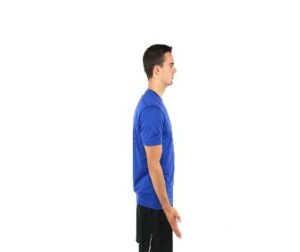

Remove the arm from the sling and straighten it down by your side.
Now bend the elbow as much as possible.
2. Pendular exercises

Rest your unaffected arm on a table and let the affected arm hang down freely.
Try to write each letter of the alphabet using this arm. As your pain improves, you can make the letters bigger by moving your arm further in each direction.
3. Shoulder flexion
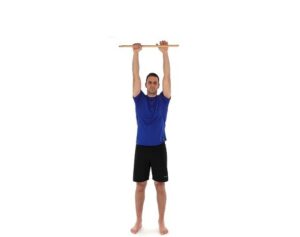
Hold a long stick in both your hands.
Allow your unaffected arm to help your affected arm lift forward and upward as high as possible.
In the early stages, you may find this easier laid down.
4. Shoulder abduction
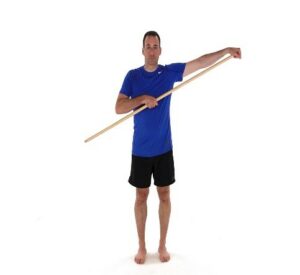
Hold a long stick in both your hands.
Allow your unaffected arm to help your affected arm lift outwards and upward as high as possible to the side of the affected shoulder
5. Shoulder internal rotation

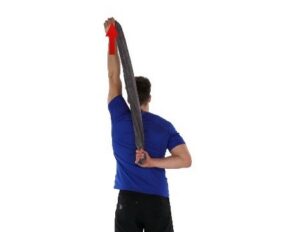
6. Shoulder external rotation
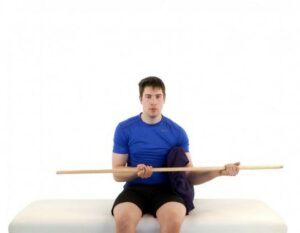
Hold a stick in both hands whilst elbows bent.
Keep your elbow tucked into your side and use your unaffected arm to push your affected arm out to the side.
All photos with kind permission of ©Physiotec™
All the exercises should be practiced 10 times, 3 to 4 times per day. Your child may experience a little more discomfort when they start them, however this is normal and does not mean they should stop. If their symptoms remain worse for more than two hours after the exercises, then they should decrease the number of each exercise that they do and build up again slowly.
When should my child start increasing their activity?
Once your child’s pain is under control, they can wean from the sling, this is usually around 2 to 3 weeks. We would however expect some discomfort in the collarbone region for 4 to 6 weeks.
The ‘bump’ over the fracture is quite normal and is produced by healing bone. It may take up to one year to disappear. If your child is older than ten years a small bump may remain.
Your child may return to everyday activities as soon as comfortable, but should avoid swimming, rough play and contact sports (such as football, rugby and basketball) until the fracture is fully healed at around six weeks. Care should also be taken whilst riding bikes and scooters in this time period
Repetitive shoulder movements and lifting objects heavier than a cup of water should be avoided to begin with. However, as your child’s movement improves and pain reduces, little by little they can increase the amount of weight that they are able to lift. Progressing quickly from lifting a cup of water to a heavy school bag for example would not be advisable, as is likely to result in overloading of the soft tissue and could consequently lead to a delay in recovery.
If your child participates in an active hobby then it is advisable that they do not return to this until they have full strength and full range of movement.
If they play a sport, they can practice sports specific activities; like throwing or catching. Build up these exercises gradually from around 6 weeks, in order to help regain strength and flexibility, before returning to full training sessions and competition.
Does my child require a follow up?
Your child does not require a follow up appointment and they have been placed on a Patient Initiated Follow up (PIFU) pathway. This means they will not have another appointment to be seen in fracture clinic.
If, however they have any problems or further queries relating to this injury within the next six weeks, you can contact us on tel: 01482 674378 during clinic hours 9.00am to 4.30pm Monday to Friday. Please do not choose an option and when prompted leave a message if there is no answer and we will aim to get back to you within the same working day. After six weeks your child will be discharged and should seek advice from your GP
This leaflet was produced by the Orthopaedic Department, Hull University Teaching Hospitals NHS Trust and will be reviewed in May 2025
General Advice and Consent
Most of your questions should have been answered by this leaflet, but remember that this is only a starting point for discussion with the healthcare team.
Consent to treatment
Before any doctor, nurse or therapist examines or treats your child, they must seek your consent or permission. In order to make a decision, you need to have information from health professionals about the treatment or investigation which is being offered to your child. You should always ask them more questions if you do not understand or if you want more information.
The information you receive should be about your child’s condition, the alternatives available for your child, and whether it carries risks as well as the benefits. What is important is that your consent is genuine or valid. That means:
- you must be able to give your consent
- you must be given enough information to enable you to make a decision
- you must be acting under your own free will and not under the strong influence of another person
Information about your child
We collect and use your child’s information to provide your child with care and treatment. As part of your child’s care, information about your child will be shared between members of a healthcare team, some of whom you may not meet. Your child’s information may also be used to help train staff, to check the quality of our care, to manage and plan the health service, and to help with research. Wherever possible we use anonymous data.
We may pass on relevant information to other health organisations that provide your child with care. All information is treated as strictly confidential and is not given to anyone who does not need it. If you have any concerns please ask your child’s doctor, or the person caring for your child.
Under the General Data Protection Regulation and the Data Protection Act 2018 we are responsible for maintaining the confidentiality of any information we hold about your child. For further information visit the following page: Confidential Information about You.
If you need information about your child’s (or a child you care for) health and wellbeing and their care and treatment in a different format, such as large print, braille or audio, due to disability, impairment or sensory loss, please advise a member of staff and this can be arranged.

